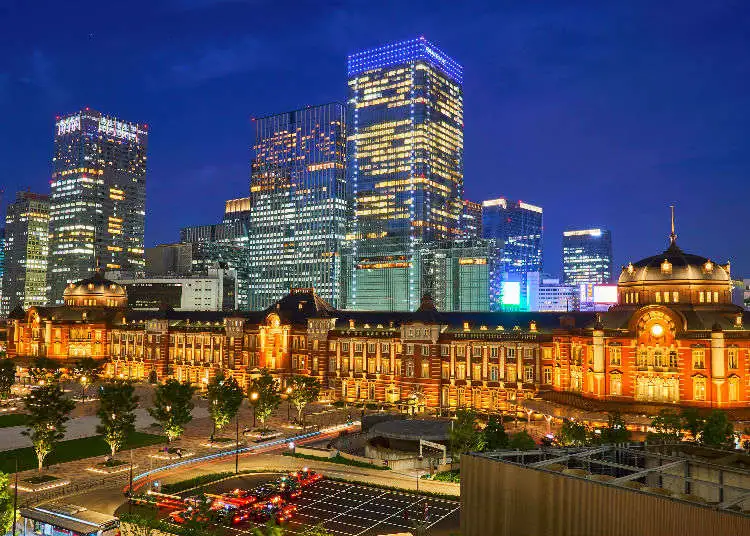
A little bit London, a little bit New York where Tokyo is tinged with the West
Marunouchi, Tokyo
When the first Shogun Tokugawa Ieyasu in 1590 began to lay hands on the Edo castle that would later become the home of the shogun (in fact a king) who would rule over all of Japan from Kanto (the Tokyo region) the area where Tokyo Station stands today was in fact a bend in the bay, a piece of beach, and so it was that gradually the shoreline was filled in with land, so as to bring out new space where the dwellings of the daimyo (feudal lords) who then had to compulsorily reside part of the year in the shogunale capital could be built.
Mitsubishi’s first modern office
Marunouchi, Tokyo With the Meiji era (second half of the 19th century) that gave birth to modern Japan by overthrowing the feudal regime the space was occupied by ministries and barracks, in 1890 upon the relocation of the latter the whole area was purchased for one and a half million yen of the time by Iwasaki Yanosuke, brother of the founder of Mitsubishi and then himself the head of the large company, who then had the company’s first office built here by Josiah Conder (an Anglo-Saxon architect) who was then responsible for also thinking about the urban design of the entire area, which was pulled up all in the English style with the characteristic red bricks, so that it would earn the name London of Japan. .. a similar look that was touching, almost simultaneously, the Ginza district. After the 1923 earthquake and bombing, the area saw so many tall buildings spring up so that it changed its name to: “the New York of the Rising Sun.”
An open-air exhibition in the heart of Tokyo
Sculpture by Atsuhiko Misawa in Marunouchi, Tokyo
The company building known as the Mitsubishi Ichigokan (i.e., first building) for security reasons was “abandoned” in 1968, to be rebuilt in the same form but reinforced with reinforced concrete, a work later completed in 2009 when the building became the home of the museum that houses part of the Mitsubishi Group’s zaibatsu art collection, which boasts many Western works from the 19th-20th centuries including more than 200 pieces by Toulouse-Lautrec. The surrounding area has also become an open-air museum with works by Henry Moore and Yayoi Kusama and others from the contemporary art world.
An Art Nouveau station in the heart of the Far East
Tokyo Station.
At the beginning of the 20th century at the time of state modernization in the area, partly to celebrate the victory over Russia, it was decided to build a new railway station, practically opposite the imperial palace; Tatsuno Kingo was commissioned for it in 1914 and built it in the European style, very similar to the Amsterdam station with two glass domes that were destroyed during the Tokyo bombings of 1945 and in the immediate reconstruction were not restored.
In 2009 in view of the upcoming centenary of its inauguration, a thorough restoration began that gave its former appearance to the station, which, in addition to the tracks (3,000 trains arrive there daily), as a Japanese custom houses a department store (Daimaru) and galleries of stores and restaurants and is by number of people who frequent it ranked fifth in Japan. On the large forecourt in front of it is the central gate, which, however , remains closed at all times or nearly so; in fact, it is intended only for emperors. In front of it is the Gyoukou dori a large avenue that connects it to the palace and is traveled by ambassadors of foreign countries, on a chariot or by car, when they deliver their letters of credence to His Majesty before settling into their diplomatic residence.
Modern and contemporary architecture in the heart of the Japanese capital
Marunouchi, Tokyo
If you want a good view of the railway junction, you can go to the nearby Kitte building, i.e., Tokyo’s recently restored and expanded main post office with a mighty skyscraper whose interiors have been redesigned by Kuma Kengo, where the sixth floor has terraces open to the public. In the recent redevelopment of this economic center of the metropolis we have witnessed the insertion of soaring skyscrapers into the neoclassical or otherwise early 20th-century structures, a very Japanese way of combining past and functionality, as also done in the nearby 1916 Bank of Tokyo. Also worth noting in the area, in the neoclassical style, is the Meiji Insurance Building (1934) inside which engineer Tachu Naito, the one behind Tokyo Tower, had inserted futuristic air conditioning and heating systems.
Below photo gallery.
For the photos in this article we thank our friend Keiko from Tokyo.
how to get there
Tokyo is one of the stops on the Yamanote line and the Tokyo Metro network.


